To understand your pay stub line by line, start by checking your personal info to verify accuracy. Review your earnings, including salary, bonuses, and overtime, then examine taxes, deductions, and contributions to see how they impact your net pay. Watch for year-to-date totals and any extra benefits or special deductions. By following each section carefully, you’ll better grasp your compensation details—keep going to learn more about each part.
Key Takeaways
- Start by reviewing personal information to ensure accuracy and security on the top section of the pay stub.
- Identify the gross pay amount, including salary, overtime, and bonuses, usually listed at the beginning of earnings.
- Examine each deduction line, such as taxes, insurance, and retirement contributions, for transparency.
- Confirm net pay, the amount deposited into your account, is correctly calculated after deductions.
- Check year-to-date totals for gross income, deductions, and net pay to track overall earnings and withholdings.
Understanding Your Personal Information Section
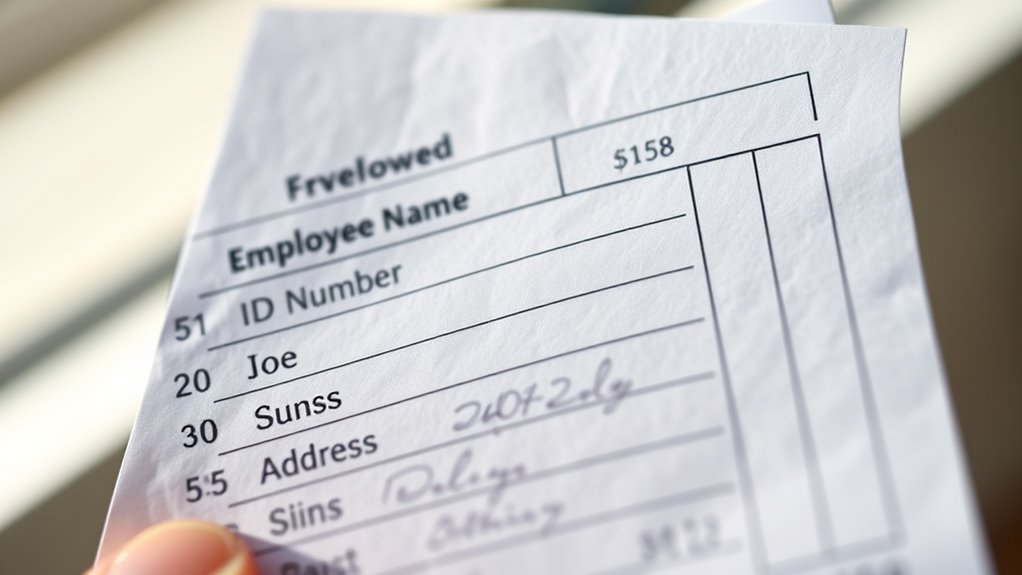
Have you ever wondered what your personal information on a pay stub reveals? This section usually includes your name, address, Social Security number, and employee ID. It helps identify you and guarantees your wages are correctly assigned. It also plays a crucial role in payroll processing procedures, ensuring that your payment information is accurately recorded. Your employer uses this info for payroll processing and tax purposes. Double-check that your details are accurate to avoid payroll errors or delays. Your name and address should match your official records, while your Social Security number is essential for tax reporting. Sometimes, your employee ID is listed for internal tracking. Remember, this information is sensitive, so keep your pay stub secure. Ensuring your personal details are correct helps prevent payroll mistakes and ensures you get paid accurately. Additionally, understanding the security measures surrounding your personal information can help you protect yourself from identity theft. Being aware of privacy policies related to your data can further aid in safeguarding your details. Recognizing confidentiality policies can also reinforce how your data is protected within your organization. To further protect yourself, consider reviewing your data security practices regularly to stay informed about potential vulnerabilities.
Breaking Down Your Earnings
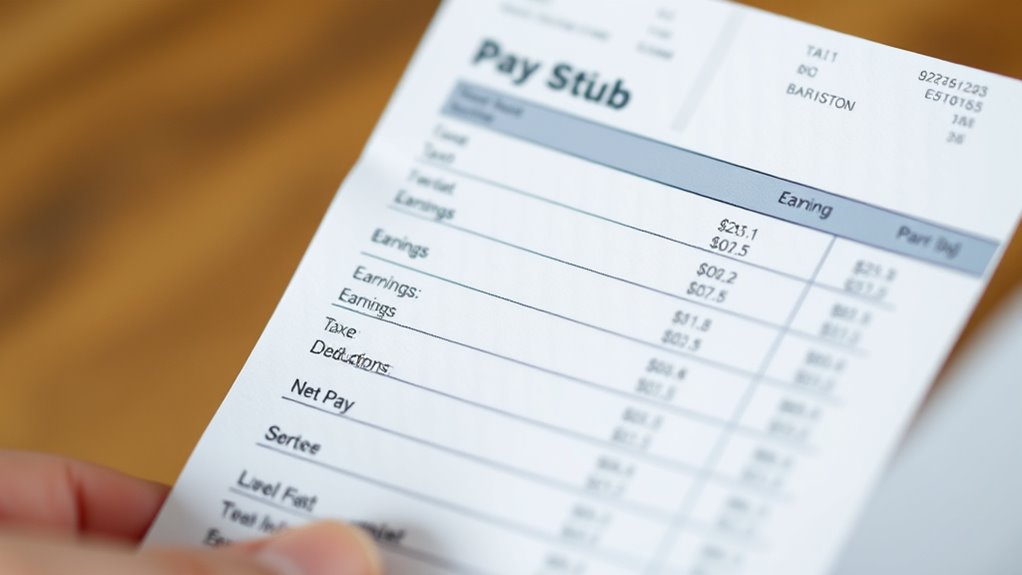
Your earnings section shows more than just your paycheck; it breaks down what you actually earn. You’ll see your gross pay versus what you take home after taxes and deductions, along with any overtime or bonuses. Understanding these figures helps you know exactly how much money you’re earning and where it’s going. Additionally, being aware of input lag and refresh rates can be helpful if you’re monitoring your gaming or entertainment expenses. Recognizing the deduction details can also give you insight into benefits like health insurance or retirement contributions that are reflected in your paycheck. Developing a clear understanding of industry trends can further assist you in managing your finances effectively. Familiarizing yourself with performance upgrades can also help you better interpret the enhancements reflected in your pay, especially if your role involves technical or product knowledge. Moreover, understanding how Glycolic Acid benefits impact skin health can be useful if your job involves personal care or skincare products.
Gross vs. Net Pay
Ever wonder what the difference is between gross and net pay? Gross pay is your total earnings before deductions, while net pay is what you take home after taxes and other withholdings. Think of gross as the full amount you earned and net as your actual paycheck. Here’s a quick comparison:
| Aspect | Gross Pay | Net Pay |
|---|---|---|
| Definition | Total earnings before deductions | Take-home pay after deductions |
| Includes | Salary, bonuses, overtime | After taxes, insurance, retirement |
| Importance | Shows earning potential | Shows what you can spend |
Understanding this helps you budget and plan better. It’s your real income, and knowing the difference keeps your financial picture clear. Recognizing the significance of conflict resolution skills can also improve how you handle financial discussions and disputes. Additionally, being aware of zodiac sign compatibility in your financial decisions may provide unique insights into your financial relationships. Just as Volkswagen Tuning offers tailored modifications for different models, understanding your pay stub allows for personalized financial planning. Being familiar with merchant services and their potential pitfalls can help you make informed decisions about your financial transactions. Knowing how to interpret your pay stub can also help in identifying discrepancies that may arise from errors or unauthorized deductions.
Overtime and Bonuses
Did you know that overtime pay and bonuses can substantially boost your paycheck beyond your regular salary? Overtime pay is usually calculated at a higher rate, often time-and-a-half, for hours worked beyond your standard schedule. Bonuses, on the other hand, are additional earnings awarded for performance, milestones, or company profits. These amounts are typically listed separately on your pay stub, making it easy to see how much extra you’re earning. Understanding pay stub details can help you better grasp your total compensation and plan your finances accordingly. Recognizing the importance of visualization techniques can help you better comprehend how your hard work translates into extra income each pay period. Additionally, being aware of data collection and usage policies can ensure your personal information remains protected while you review your earnings. Keep an eye on these figures to better grasp how your hard work translates into extra income each pay period.
Deductions and Taxes
While overtime and bonuses can considerably increase your paycheck, it’s important to understand how deductions and taxes affect your net earnings. Deductions are amounts taken out of your gross pay, including federal and state taxes, Social Security, Medicare, and any voluntary contributions like retirement plans or health insurance. These taxes fund programs and services you benefit from, but they also reduce your take-home pay. Your pay stub will list each deduction separately, so you can see exactly where your money is going. It’s helpful to review these details regularly to ensure accuracy. Remember, the more taxes and deductions you have, the less you’ll see in your pocket. Understanding these line items helps you better plan your finances and avoid surprises. Being aware of tuning benefits can also inform how you manage your finances if you own a vehicle. Incorporating organization techniques can help you keep track of your deductions and plan for future expenses more effectively. Additionally, understanding pay stub literacy can empower you to identify any errors and advocate for yourself if needed. Recognizing pay stub components can also help you understand how each element contributes to your overall compensation.
Reviewing Your Tax Withholdings
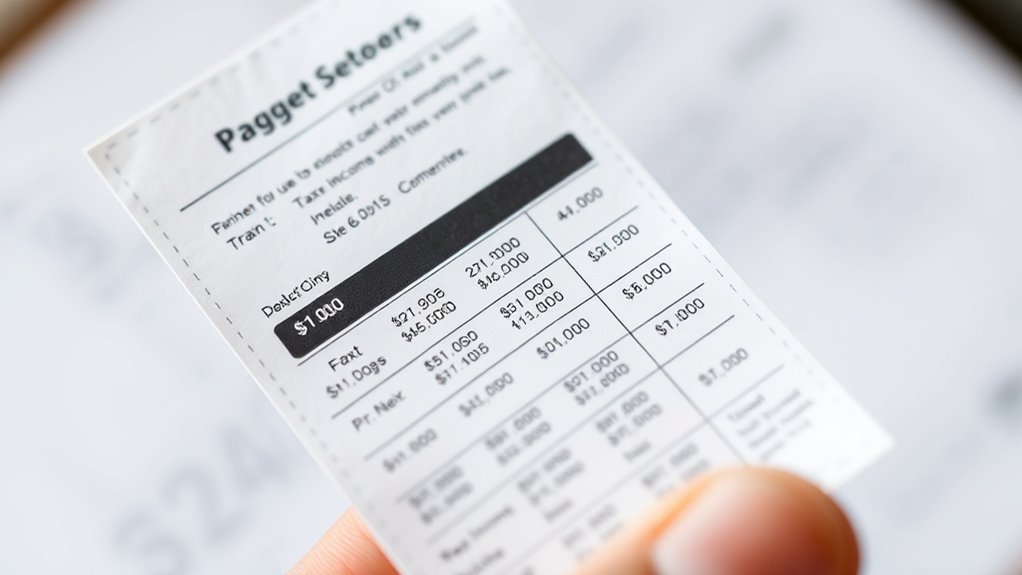
Now, it’s important to review your tax withholdings to guarantee the right amount is being taken out. You should check your federal withholding calculations and see if your state deductions are accurate. Making adjustments now can help prevent surprises at tax time.
Calculate Federal Withholding
Have you ever wondered if your federal tax withholding is accurate? To check, start by reviewing your pay stub’s withholding amount. Use the IRS tax tables or withholding calculator to see what your employer should deduct based on your income, filing status, and allowances. Compare this to what’s actually withheld. If you’re having too much or too little taken out, you might need to update your Form W-4. Making sure the right amount is withheld helps prevent surprises at tax time or owing money. Remember, accurate withholding balances your paycheck and tax obligations, avoiding penalties or large refunds. Regularly reviewing your pay stub ensures your federal withholding aligns with current tax laws and your financial situation.
Adjust State Deductions
Ever wonder if your state tax withholding matches your current financial situation? Checking your pay stub helps you see if enough money is being deducted for state taxes. If it’s too high, you might be overpaying and could get a refund at tax time. If it’s too low, you could owe money when you file. To adjust your deductions, review the amount withheld compared to your expected tax liability. You may need to update your W-4 form with your employer or adjust your exemptions to better reflect your current income and deductions. Keep in mind that some states have different rules, so it’s wise to consult your state’s tax website or a tax professional. Regularly reviewing your deductions ensures you’re not caught off guard during tax season.
Examining Other Deductions and Contributions
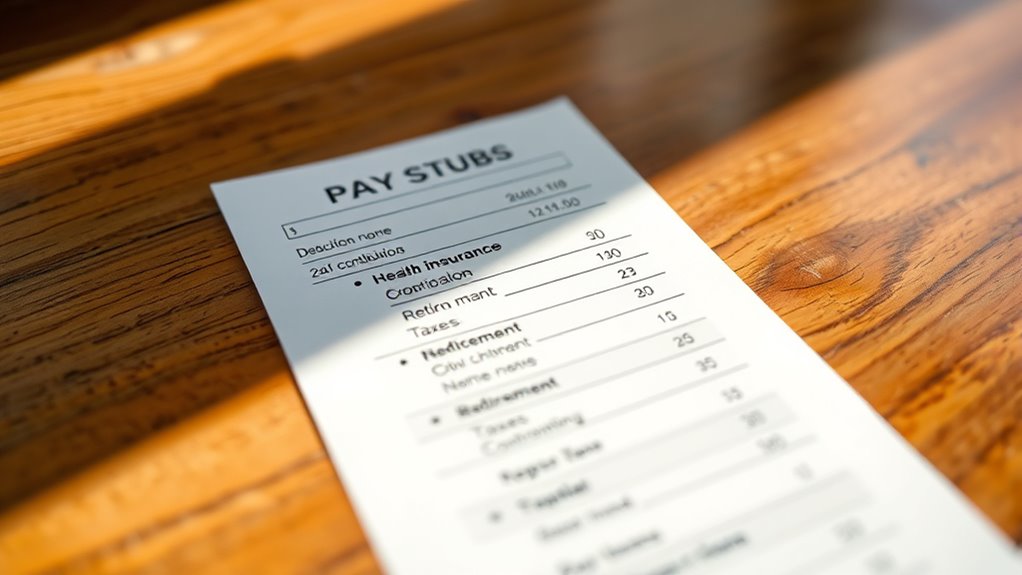
When reviewing your pay stub, it’s important to pay attention to other deductions and contributions beyond taxes and wages. These may include health insurance premiums, retirement plan contributions, life insurance, and union dues. Each deduction serves a specific purpose, affecting your take-home pay and future benefits. Check whether your employer offers any pre-tax options, which can lower your taxable income. Review the amounts carefully to ensure they match your selections or agreements. If you see unfamiliar or unexpected deductions, don’t hesitate to ask your HR department for clarification. Understanding these contributions helps you see the full picture of your compensation package and how much is allocated toward benefits and savings. This awareness empowers you to make informed decisions about your financial planning and benefits.
Calculating Your Gross Pay
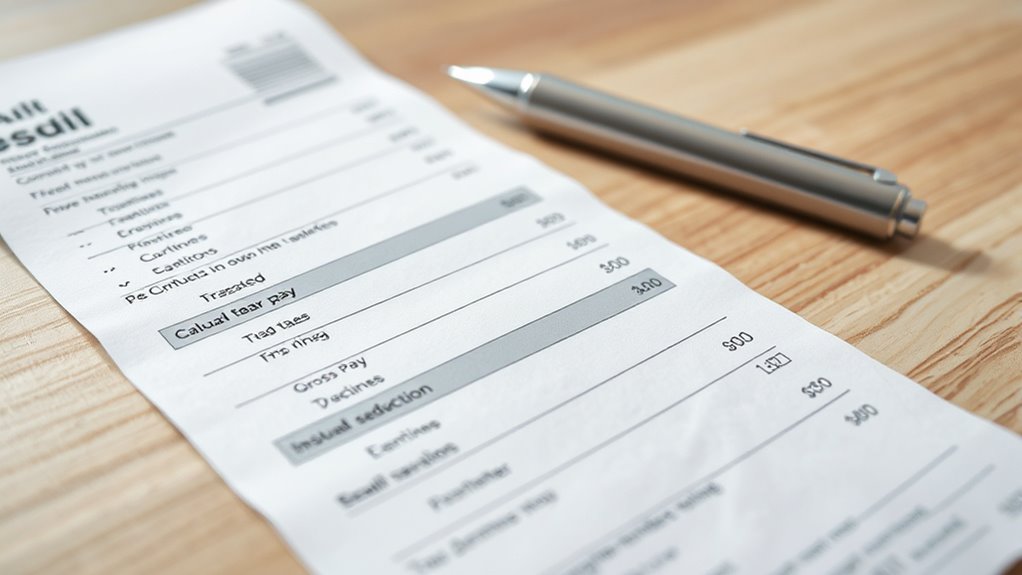
Understanding how to calculate your gross pay is essential for reviewing your pay stub accurately. Your gross pay is the total amount earned before any deductions. To determine it, start with your hourly wage or salary. If you’re paid hourly, multiply your hours worked by your hourly rate. For salaried employees, divide your annual salary by the number of pay periods. Here’s a quick overview:
| Pay Type | Calculation | Example |
|---|---|---|
| Hourly | Hours worked × hourly rate | 40 hours × $15 = $600 |
| Salaried | Annual salary ÷ pay periods | $52,000 ÷ 26 ≈ $2,000 |
| Overtime | Overtime hours × overtime rate | 5 hours × $22.50 = $112.50 |
| Bonuses/Commissions | Add to total gross pay | Bonus of $500 added |
This helps you verify the accuracy of your gross earnings.
Verifying Your Net Pay

Have you checked your pay stub to confirm that your net pay matches your expectations? This step is vital to guarantee accuracy. Look at the “Net Pay” or “Take-Home Pay” section, which shows the amount you actually receive. Compare this figure to what you expected based on your hours worked and pay rate. If there’s a discrepancy, review your deductions and taxes listed on the stub. Mistakes can happen, so double-check that all hours and pay rates are correct. Also, confirm that any overtime or bonuses are included if applicable. Verifying your net pay helps catch errors early, preventing confusion or issues with your paycheck. Regularly reviewing this amount keeps you informed and confident about your earnings.
Recognizing Year-to-Date Totals

Recognizing your year-to-date totals on a pay stub provides a clear overview of your earnings and deductions over the course of the year. These totals are usually found in a dedicated section labeled “YTD” or “Year-to-Date.” They include your total gross income, taxes withheld, retirement contributions, health insurance premiums, and other deductions accumulated from the start of the year. By reviewing these figures, you can track your progress toward savings goals, verify that your employer has reported accurate information to tax authorities, and spot any discrepancies early. It is crucial to familiarize yourself with these totals regularly, especially when preparing for taxes or financial planning. Understanding your year-to-date information helps you stay informed about your overall financial picture.
Spotting Additional Benefits or Deductions
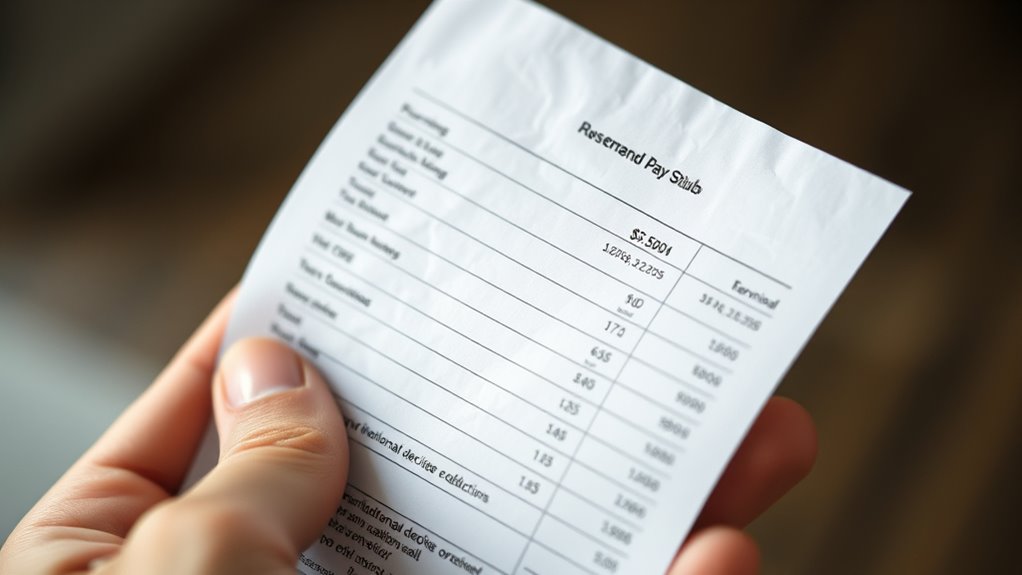
While reviewing your pay stub, it’s important to look beyond the basic income and tax figures to identify any additional benefits or deductions. These might include employer-sponsored health insurance, retirement contributions, or flexible spending account deductions. Check for line items labeled as “Benefits,” “Insurance,” or “Retirement,” which often detail these extras. Some deductions are pre-tax, reducing your taxable income, while others are post-tax. Be aware of voluntary benefits like life insurance or union dues, as well as mandatory ones like garnishments. Recognizing these items helps you understand your total compensation package and ensures there are no unexpected charges. Taking note of all additional benefits and deductions allows you to better manage your finances and confirm your pay stub accurately reflects your benefits.
Using Your Pay Stub to Manage Finances

Ever wonder how to turn your pay stub into a useful financial tool? Your pay stub provides a clear snapshot of your income and deductions, helping you track your financial health. Use it to verify your pay, ensuring accuracy in hours worked and pay rate. Review deductions to understand where your money goes, including taxes, benefits, and other withholdings. Keep an eye on your net pay to plan your budget effectively. Regularly checking your pay stub helps identify discrepancies early and prevents errors from slipping through. By understanding each line, you can manage your expenses better, save smarter, and set financial goals confidently. Your pay stub isn’t just a record; it’s a tool to help you make informed financial decisions.
Frequently Asked Questions
How Often Are Pay Stubs Typically Issued?
You probably wonder how often pay stubs are issued. Typically, employers give them to you with each paycheck, whether you’re paid weekly, biweekly, semimonthly, or monthly. Some companies provide online access, so you can check your pay stub anytime. The frequency depends on your employer’s payroll schedule, but most workers receive a pay stub every time they get paid, ensuring you can verify your earnings and deductions regularly.
What Should I Do if My Pay Stub Info Is Incorrect?
If your pay stub info is incorrect, you should act quickly. Contact your payroll or HR department right away to report the mistake. Provide clear details about what’s wrong and any supporting documents. Keep a copy of your pay stub and your communication for records. Follow up if needed until the issue is resolved. Don’t ignore errors, as they could affect your taxes or benefits.
Can I Access My Pay Stub Electronically?
You can usually access your pay stub electronically through your company’s payroll portal or HR system. Many employers offer online platforms where you can log in securely using your employee credentials. Check your email or company website for instructions. If you’re unsure, contact your HR department or payroll administrator—they’ll guide you on how to access or set up electronic pay stub access, making it quick and easy.
How Do I Interpret Overtime or Bonus Pay?
Imagine your pay stub as a treasure map, guiding you through hidden gems like overtime or bonuses. Overtime pay shows extra treasure for hours worked beyond your usual, often at a higher rate. Bonuses are like special rewards added to your loot, usually listed separately. To interpret them, look for labels like “OT” or “Bonus,” and note the amounts. They boost your total earnings and reflect your extra effort or achievements.
Are There Legal Requirements for What Must Be on a Pay Stub?
You should know that legal requirements for pay stubs vary by state, but generally, they must include your gross wages, deductions, net pay, hours worked, pay rate, and employer details. These rules help guarantee transparency and prevent disputes. If your pay stub lacks any required info, you can request clarification from your employer or consult your state’s labor department to understand your rights and ensure your pay stub complies with the law.
Conclusion
Now that you know how to read your pay stub line by line, you’ll uncover details you might have overlooked. But what if there’s more hidden within those numbers—things that could impact your finances in unexpected ways? Stay vigilant and keep exploring every section. Your pay stub isn’t just a record; it’s a powerful tool to master your money. Ready to reveal its secrets and take control of your financial future? The real insights are just ahead.









